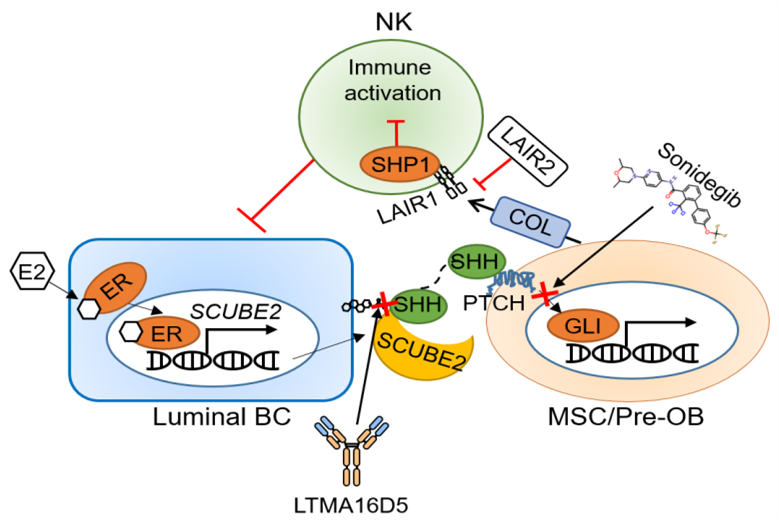- Home >> ALL News >> Highlights
Researchers Reveal Key Mechanism of Bone Metastasis Tropism in Luminal Breast Cancer
A research team led by Prof. HU Guohong from the Shanghai Institute of Nutrition and Health (SINH), Chinese Academy of Sciences (CAS), revealed the key mechanism of bone metastasis tropism in luminal breast cancer, providing a new biomarker in clinical diagnosis and strategies for bone metastasis treatment.
Breast cancer is the leading threat to women worldwide, while distant metastasis is the main cause of death in breast cancer patients. Breast cancer cells metastasize to several organs in the body, with the bone as the most frequent target site. Breast cancer can be classified into several subtypes according to the expression of cell surface markers. Bone metastasis is found to occur dominantly in luminal breast cancer (LBC) subtype positive for estrogen receptor (ER). However, the risk of metastasis to non-bone organs is significantly lower in LBC than in other subtypes. The mechanisms driving bone selectivity of LBC remain elusive. In addition, most drugs used in clinical treatment for bone metastasis are developed based on triple-negative subtype, while failing to achieve good therapeutic effects.
In this study, the researchers identified a secretory protein SCUBE2, which is significantly upregulated in LBC and promotes bone metastasis in multiple mouse models. SCUBE2 is regulated by ER signaling and facilitates SHH secretion from tumor cells. SHH activates Hedgehog signaling of pre-osteoblasts in bone microenvironment and further promotes osteoblast differentiation. Osteoblasts deposit COL1 and inhibit NK activation through the COL1-LAIR1-SHP1 axis, thus protect tumor cells from immune surveillance.
Then, the researchers found that using FDA-approved Hedgehog signaling inhibitor Sonidegib significantly inhibits bone metastasis of breast cancer. In addition, the research team developed a SCUBE2 neutralizing antibody, which can block the function of SCUBE2 and presents good therapeutic effects on bone metastasis in multiple mouse models.
“Our work answers the longstanding question about high risk for bone recurrence in luminal breast cancer and provides prognostic and therapeutic values in clinical,” said Prof. HU, corresponding author of this study. “In addition, the newly identified immune-suppressive role of osteoblast will enrich the understanding towards osteogenic niches in bone metastasis.”
This study reveals the crucial role of SCUBE2 in regulating bone metastasis of luminal breast cancer, and supports its significance in clinical diagnosis and in bone metastasis treatment. Moreover, the specific expression of SCUBE2 in LBC and its functional dependence on osteoblasts explain the unique metastasis tropism of LBC to bone, but not to other organs.
Entitled “SCUBE2 mediates bone metastasis of luminal breast cancer by modulating immune-suppressive osteoblastic niches”, this study was published in Cell Research on May 4th, 2023. It was supported by the National Natural Science Foundation of China, the National Key R&D Program of China, the Science and Technology Commission of Shanghai Municipality and the Youth Innovation Promotion Association of CAS.

A schematic model depicting the role of SCUBE2 in bone metastasis of LBC. (Image by Prof. HU’s group)
Media Contact:
WANG Jin
Shanghai Institute of Nutrition and Health,
Chinese Academy of Sciences
Email: wangjin01@sinh.ac.cn
Web: http://english.sinh.cas.cn/


